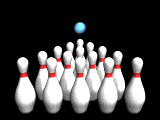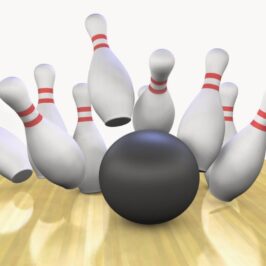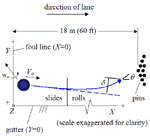Bowling in the US is dominated by 10-pin bowling, but there are several other types of bowling that have different rules, equipment, and methods of play. Some use pins and balls that are different from regular 10-pin bowling, such as candlepin bowling and bowls.
 |  |
Origins of Nine Pin Bowling
Nine-pin bowling (also known as kegel) is very different from 10-pin, and not just because there’s one less pin. For example, 9-pin is a team game, so there are no individual scores. There are six players on a team, and each player takes two turns. Another major difference from 10-pin bowling games is that the pins in 9-pin are not re-set between each player. Instead, the next player simply picks up where the previous player left off until all the pins have been knocked down, at which point the pins are re-set. Another twist in 9-pin: the pins are set up in a diamond formation instead of a triangle. The pins are white, except for the center pin, which is red and is known as a “12-pin” or “redhead.” If a player knocks down every pin in one turn, they are awarded 9 points. However, if they manage to knock down all the pins except the red pin, they are awarded 12 points, as this is a much harder feat. The pins the pins are configured in a diamond shape, with a red pin in the middle. All games of 9-pin are manually set by a human pin-setter. Each game is 6 frames. There are two turns per frame, even if all pins are knocked down on the first turn.
In the 1830s, several cities in the United States banned nine-pin bowling out of moral panic over the supposed destruction of the work ethic, gambling, and organized crime. Kegel remains popular in Europe and enjoys a cult-like following in central Texas, thanks to the large German population that settled there. Ninepin alleys were numerous enough in Texas by 1837 that rather than a ban, the 1st Congress of the Republic of Texas chose to subject them to an annual tax, and all forms of bowling have remained legal and subject to taxation in Texas ever since. Today, nine-pins has disappeared from all of the United States except Texas, where both nine and ten pin bowling have been known since the 1830s. Standardized rules and organization of nine-pins were developed by the American Bowling Congress in 1895. Nine-pin was actually one of the most popular types of bowling in the US until the early 20th century, when authorities linked it to organized crime and thus made it illegal. It was replaced by ten-pins. Ten-pin bowling is said to have been invented in order to meet the letter of these laws. By World War I most Texas bowling establishments, both private and commercial, had changed to ten-pins. However, nine-pins remained popular in predominantly German communities like Fredericksburg, New Braunfels and Bulverde. There are nine-pins clubs in the small outlying communities of Bexar, Comal, and Guadalupe Counties.
 |  |
Everything’s a little different in Canada, and bowling is no exception. In this variation, 5 pins are arranged in a V shape, and each is worth a unique number of points. Players toss a hand-sized ball down the alley, trying to hit the center pin for 5 points and cause a domino effect to clean up 15 total points. It’s possible to achieve a perfect 450-point game, but that task is even more difficult than nailing a 300 in 10-pin. There are 10 frames with each player getting 3 turns. It was devised around 1909 by Thomas F. Ryan in Toronto, Ontario, at his Toronto Bowling Club, in response to customers who complained that the ten-pin game was too strenuous. He cut five tenpins down to about 75% of their size, and put a heavy rubber band around their middles, similar to the pins used in the rarely seen “rubberband duckpin” form of duckpin bowlingand, and used hand-sized hard rubber balls. Five-pin bowling balls are small enough to fit in the hand, so they do not have finger holes.

The Canadian 5-Pin Bowling Association is the governing body.
Lawn Bowling – “Bowls”
| 0 – None | Pin Size |  Ball Size Ball Size |  |

Lawn Bowling is a popular “other” form of bowling, played mostly in warmer climates such as Florida. It uses a ball that is not round and is played on grass.
Candlepin Bowling
This variant of 10-pin bowling is included here because of the pins used.
| 10 |  |  |
3-Pin Bowling
OK. This has to be the extreme unless there’s a 1-pin game somewhere. This might be the only place in the US that has a 3-Pin game. Corner Bar & Grill in St Charles, Missouri has a 3-pin game. This is more fun and a novelty than “serious” bowling, so if you’re in the region, check it out.


[whohit]Other Forms of Bowling[/whohit]








Leave a Reply